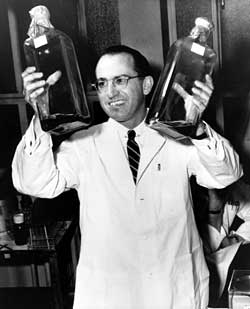Less Science in Pennsylvania
June 18, 2010
Pennsylvania has been home to quite a few scientists. Just to name one of the earliest and best known, there's
Benjamin Franklin. I did my post-doctoral work at the
University of Pittsburgh, my son and daughter have advanced degrees from Pennsylvania universities, and they both presently reside in Pennsylvania. Pennsylvania is a really nice place to live.

Jonas Salk.
Salk developed his polio vaccine at the University of Pittsburgh.
Pennsylvania is not isolated from national trends. One of these trends is the reduced number of students pursuing careers in science, technology, engineering and mathematics (
STEM). Building a career in any of these areas is difficult. Not only is STEM education more demanding than that of other subject areas, job prospects are generally bleak.
Industrial laboratories in the United States used to employ quite a number of scientists and engineers, but now many of these research positions have been
outsourced to other countries. In fact, many technically-educated collegiates have decided to become tradesmen. [1] High school graduates clearly see these trends, and they choose not to major in STEM areas in college.
There are fourteen state-run universities in Pennsylvania. Pennsylvania, like all states, is feeling a budget crunch, and it's been announced that degree programs with low enrollment, such as physics, will be no longer be resisident at each campus. Instead, faculty will be shared among campuses. Kevin Kodish of the
Association of Pennsylvania State College and University Faculties stated the obvious when he said, "The potential impact down the road is simple: it'll reduce staffing." [2] As one example, a physics BA program will be shared between
Clarion,
Edinboro,
Mansfield and
California University of Pennsylvania. The programs affected at
Indiana University of Pennsylvania include the associate of arts degree in electro-optics, bachelor of science in environmental health, bachelor of science in applied mathematics, bachelor of arts in mathematics-economics, bachelor of arts in physics and master of arts in physics. [2]
The state would like this trend towards fewer faculty members to propogate to the more highly enrolled subject areas, as well. The lecture hall will eventually be supplanted by a
distance-learning application on the student's computer. Although the audio recordings [3] of the
Feynman Lectures on Physics were an excellent instructional medium in their time, is
Feynman in a Box the way to teach physics? Our university system is turning into a conduit for something like the language instruction courses we see advertised on cable television. Is this any way to teach STEM?
References:
- Carol Morello, "More college-educated jump tracks to become skilled manual laborers," Washington Post Online (June 15, 2010).
- Bill Schackner, "Pennsylvania universities put some degrees on hold," Pittsburgh Post-Gazette Online (June 15, 2010); also available here.
- Available on CD here. (Not recommended for starving students - A complete set will run more than $400).
Permanent Link to this article